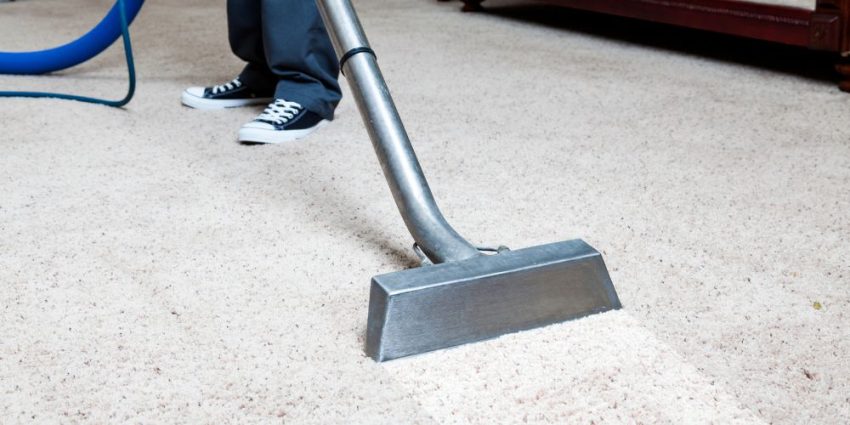Office carpet does hard work. Every day, it absorbs dust from shoes, spills from mugs, and fine grit blown in by the HVAC. Much of that soil sinks past the visible layer. A quick vacuum gives the floor a tidy look, yet most embedded dirt stays put.
Over time, those particles grind away at the fibers and hold on to odors. That is why commercial carpet cleaning must go beyond routine housekeeping.
Routine Vacuuming vs. Deep Carpet Cleaning
Standard vacuums lift loose fluff and tracked-in crumbs. They cannot break the bond between sticky residue and yarn or remove debris that has settled near the backing. Research from the Carpet and Rug Institute shows most household vacuums miss a large share of embedded soil.
Deep carpet cleaning adds hot water, detergent chemistry, and high extraction power to flush out that hidden load.
How Professional Carpet Cleaners Reach the Deep Layer
A carpet cleaner company chooses methods based on fiber type, traffic, and the client’s schedule.
- Hot water extraction – Water near boiling mixes with a rinsing agent and is pulled back by a strong vacuum. This common form of professional deep carpet cleaning reaches the base of the pile and removes allergens.
- Low-moisture encapsulation – A polymer spray surrounds soil particles. After drying, normal vacuuming lifts the crystals away. Dry time is about one hour.
- Dry compound – Detergent-charged granules brushed through the pile absorb soil and are then vacuumed. No waiting for dry floors, so stores use it overnight.
- Bonnet cleaning – A rotating pad dampened with cleaner rubs the surface. It improves appearance fast, but it should be paired with extraction later.
- Restorative extraction – For neglected floors, technicians may pre-agitate with counter-rotating brushes and use higher pressure.
Whether truck-mounted or portable, the deep clean carpet cleaner brings more heat and airflow than in-house equipment. Technicians also set up air movers so the carpet dries before staff return.
Understanding Office Carpet Soil Types
Office carpets face three main categories of soil:
- Dry particulates such as sand and paper dust. These make up the bulk of the weight and are easiest to vacuum.
- Greasy films from shoe polish, asphalt residue, and food oils. They bond to yarn and trap more dirt.
- Spots and spills like coffee or ink that etch staining rings if ignored.
A professional team tests pH and fiber before choosing a solution. Using the wrong detergent can set a stain or strip a dye. The right chemistry lifts soil without harming nylon, olefin, or wool blends.
Pre-Inspection and Post-Inspection Process
Good carpet care starts with a walk-through. Technicians log traffic patterns, note seams, and measure humidity. After cleaning, they groom the pile and take moisture readings at several points. A report with photos and readings proves the job met industry dry-time targets, typically under six hours for extraction.
Why Specialized Carpet Cleaning Is Important

Specialized cleaning matters for these reasons:
- Appearance – Uniform, clean carpet sends a positive message to visitors and employees. Stains and traffic lanes suggest poor upkeep.
- Indoor air quality – Carpets trap fine dust until they fill up. Each footstep then releases particles back into the air. Removing the soil load improves air quality and reduces odor complaints.
- Health and safety – Spills that soak through the backing can feed mold. Proper extraction and fast drying limit that risk and reduce slip hazards from oily residue.
- Longer life – Dirt acts like sandpaper. Pulling it out slows yarn wear and can double a floor’s service life, saving on replacement budgets.
Also read: How Often Should You Clean Your Office Carpets
Creating a Commercial Carpet Care Schedule
Needs differ by space, but this simple outline works for many offices:
- Vacuum high-traffic lanes daily.
- Treat spots as soon as they happen.
- Use a low-moisture deep clean every 2–3 months in busy areas.
- Plan hot water extraction every 6–12 months.
A qualified provider will adjust the plan after inspecting the fiber type and use patterns.
Questions to Ask Before Hiring a Carpet Cleaner Company
Clear answers show the company values quality and risk control.
- Are your technicians certified in commercial carpet cleaning?
- What average dry time do you achieve?
- Do you rinse with clear water to remove detergent?
- Can you supply written reports for facility records?
- How will you protect the surrounding furniture and walls?
Signs It’s Time for a Deep Carpet Cleaning Service
Seeing two or more of these signs means a deep clean carpet service is due soon.
- Traffic lanes stay gray after vacuuming.
- Spots keep coming back.
- Odors linger when the HVAC fan stops.
- Employees report more sneezing or coughing.
Eco-Aware Products and Sustainable Cleaning
Many facility managers now ask about the environmental profile of cleaning agents. A large number of carpet crews are currently working with low-VOC detergents labeled with the Green Seal label. The formulas are rinseless and neutral in pH; hence, they require less water and leave minimal residue. This makes the carpet cleaner in between.
For drying, workers set out air movers with built-in HEPA filters. These fans run quietly, push clean air over the fibers, and cut the drying time. These choices support corporate sustainability goals without adding cost.
Choose Moonshine Commercial Cleaning
Moonshine crews are trained on every method listed here. We carry moisture meters, calibrated rinse injectors, and portable units for high-rise sites. Each job receives a photo report and a measured dry-time log. Whether you need a quick low-moisture pass or full extraction, we bring the right equipment and experience.
Take the Next Step Toward Cleaner Carpets
Hidden dirt will not leave on its own. Keep your image, air quality, and budget on costly flooring, and book carpet cleaning with a professional before the next high season. Moonshine Commercial Cleaning can be contacted at 208-219-5198 or info@moonshine-cleaning.com for a no-cost carpet check and individualized plan that fits your schedule.

